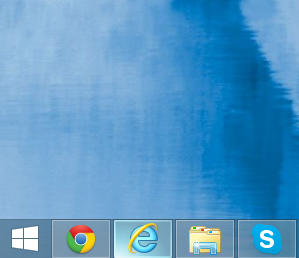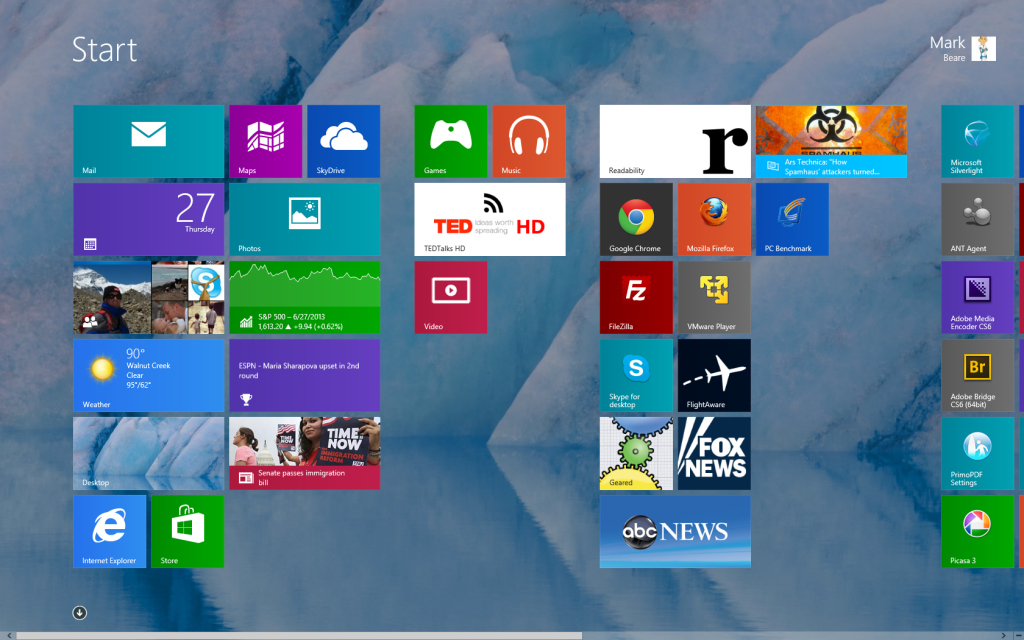| Biz ancak bu sayfa şu anda Google Translate kullanarak çevrilen makine, mümkün olduğunca çok dilde web sitemizi lokalize için çaba. | yakın |
-
-
ürünler
-
kaynaklar
-
destek
-
şirket
-
, Windows 8.1 Başlat MenüsüThe Windows 8.1 Start Menu
Tarafından Mark Beare Haziran 28, 2013start button, start menu, start screen, windows 8, windows 8.119 CommentsWindows 8.1 Başlangıç Menüsü ve Başlat Düğmesi Advent
26 Haziran’da Microsoft, Build geliştiricileri konferansında Windows 8 1 tüketici ön izlemesinin yayınlandığını duyurdu. 8.1’de Windows 8’e göre önemli miktarda değişiklik yapıldı. Microsoft ile ilgili her konuda uzman olan Paul Thurrott, tüm bu değişikliklerin kapsamlı bir listesini sunuyor .
Uzmanlar ve kullanıcılar arasında en çok beklenen değişiklik, Windows masaüstünün sol alt köşesi – Başlat Menüsü ile ilgilidir. Windows 8.1 Başlat Menüsüne Girin!
Bu bir Başlat Menüsü değil, bir düğme
Çoğu kişi Başlat Menüsü ve Başlat Düğmesinin bir ve aynı olduğunu düşünür. Son zamanlarda yaptığımız bir araştırmada, rastgele Windows kullanıcılarından oluşan bir ankette, katılımcıların% 76’sı ya farkı bilmiyordu ya da Başlat Menüsü ve Başlat Düğmesi’nin aynı şey olduğunu düşünmüşlerdi. Windows 8.1’de, durum böyle değil. Microsoft, geleneksel Başlat Menüsü’nü değiştirmek için Windows 8’de Başlangıç Ekranını tanıttı. Windows 8.1’de tanıtılan yeni Başlat düğmesi sizi Başlangıç Ekranına götürür. İşte yeni düğme nasıl görünüyor.
Gördüğünüz gibi, Windows 7 ve önceki sürümlerinde Başlat Menüsünü açan tanıdık Başlat Düğmesinin Windows 8 sürümüne benziyor. Bu, Masaüstünü geçmiş Windows sürümlerine daha aşina hale getirmeye yardımcı olur. Bununla birlikte, yeni Başlat Düğmesine tıkladığınızda, hızlı bir şekilde Windows’un önceki sürümlerinde olmadığınızı fark edersiniz.
Microsoft, Masaüstünden alındığınızda daha az şok edici hale getirmek için Başlangıç Ekranında değişiklikler yaptı. Bunu yapma şekilleri, Masaüstü arka planınızın Başlangıç Ekranı için arka plan olarak kullanılmasına (varsayılan ayar değil) olanak tanımaktır. Bu size, Başlat Ekranına girdiğinizde, henüz siz olmasanız bile, hala Masaüstü ortamında olduğunuz izlenimini verir. Masaüstünüzün açık penceresiz açılmış olması ve Başlat Düğmesi’ne basmanız durumunda, Masaüstünüzde olduğunuzu hissediyorsunuz. Bu deneyimin bir videosu için aşağıya bakın.
Sorun, gerçekte, insanlar herhangi bir pencerenin açılmasına gerek kalmadan nadiren Masaüstünde. Genellikle tarayıcı veya Outlook veya başka bir uygulama gibi en az bir uygulama açık. Masaüstünde en az bir pencere açıkken, Başlangıç Ekranına gitme deneyimi biraz daha kopuktur. Aşağıdaki bu deneyimi görün:
Bu hala insanların Windows 8’in ilk sürümüyle eleştirdiği aynı ayrıksız deneyim. Bu örneği düşünün: Bir Excel elektronik tablosu üzerinde veya başka bir çalışma parçasında çalışıyorsunuz ve daha sonra başka bir uygulamayı açmak için Başlat Düğmesine tıklıyorsunuz ve Artık Excel elektronik tablonuzu göremezsiniz ya da üzerinde çalıştığınız her neyse. Nereye gitti ve oraya nasıl geri dönebilirsin?
Başlangıç Ekranından yapamadığınız şey
Başlangıç Ekranı, eski Başlat Menüsünü değiştirmek için tanıtıldı. Eski Başlat Menüsü dokunmatik ekranlı cihazlarla çok iyi çalışmadı – tüm öğeler çok küçük olduğu için parmağınızla menüde bir şey denemek ve seçmek çok zordu. Yeni Başlangıç Ekranı, dokunma ile son derece iyi çalışır, ancak Başlat menüsünü kullanmaya kıyasla, (özellikle bir fare ve klavye ile) yapamayacağınız veya kolayca yapamayacağınız bazı şeyler vardır. Başlat Menüsü’yle karşılaştırıldığında Başlangıç Ekranından nelerin eksik olduğu:
Son Belgeleri Görüntüle
Son birkaç gündür bir belgede çalışırken ve çalışmalarınıza devam etmek için hızlı bir şekilde açmak isterseniz, Başlat Menüsü’ndeki Son Kullanılan Öğeler listesine gidebilirsiniz. En yeni öğelerinizin erişmiş olduğunuz bir listesini bulacaksınız, bu da son belgenin hızlı ve kolay bir şekilde bulunmasını sağlar. Windows 8 ve 8.1’de artık yeni belgelerin bir listesi yok. Şu anda sahip olduğunuz tek seçenek, belgeyi kullandığınız uygulamayı açmak ve buradaki son açılan belgelere bakmak veya dosyayı kaydettiğiniz yeri hatırlarsanız dosyayı doğrudan açmaktır.
Kontrol Paneline Erişim
Kontrol Paneli, bazı insanların sık kullanmadıkları bir şeydir, ancak yaptıkları zaman, genellikle önemli nedenlerden dolayıdır. Windows 8’deki Windows Denetim Masası, Başlangıç Ekranında bulunmuyor. Ayarlar seçeneğinin altındaki sağ taraftaki Takas Çubuğunda yer alır (ancak, yalnızca Takas Çubuğuna eriştiğinizde masaüstündeyseniz) veya Windows 8.1’deki yeni Başlat Düğmesini sağ tıklayıp Menüden Kontrol Paneline erişebilirsiniz. oraya geliyor. Bunlar, önceki sürümlere kıyasla Kontrol Paneline ulaşmanın çok farklı yollarıdır ve alışması biraz zaman alır.
Güç Ayarlarına Erişim
Windows’un önceki sürümlerini kullanan herkes, Başlat Menüsünü açmaya ve ardından Bilgisayarı Uyku, Yeniden Başlatma veya Bilgisayarı Kapatma için Kapatma menüsüne tıklamaya alışkındır. Windows 8’de bu değişti. Başlat Düğmesine tıklayarak güç seçeneklerine erişemezsiniz. Bilgisayarınızı kapatmak için sağdaki Charms Bar’a ve ardından Ayarlar’a ve ardından Güç’e erişmeniz gerekecektir. Ya da, Windows 8’deki yeni Başlat Düğmesini sağ tıklatıp Kapat’ı tıklatın. Bu, insanların yaptıklarından farklıdır ve asılmak için zaman alacaktır.
Hızlı bir şekilde ihtiyacınız olanı bulun
Windows 8 Başlangıç Ekranı kolayca kişiselleştirilecek ve bunun için zamanınıza bir yatırım gerektirecektir. İster istediğiniz gibi ayarlayın, ister varsayılan durumda bırakın (birçok insanın hayal edeceğini tahmin ediyorum), Başlangıç Ekranı ile çok zor bulduğum bir şey var – aradığım şeyi bulmak biraz zaman alıyor için. Bu, Başlangıç Ekranı’nda yatay olarak yatay olarak yerleştirilmekte olan karolarla ilgilidir. Her bir dikey listeyi gözlerinizle taramanız ve daha sonra sağa ilerleyip bir sonraki listeyi taramanız ve istediğiniz aramayı bulana kadar devam etmeniz ya da hiç bulamadan sonuna kadar vurmanız gerekir. Bu noktayı kanıtlamak için, aşağıdaki listede Kireç kelimesini bulmaya çalışın.
elma
Muz
Yaban mersini
Üzüm
Guava
kivi
Limon
Misket Limonu
Mango
Kavun
Şeftali
Portakal
şeftali
Ananas
çilek
DomatesBu listenin alfabetik olarak sıralandığını bile söylemedim ve eminim ki kelimeyi gerçekten çabuk buldu. Şimdi, Windows 8 Başlangıç Ekranı gibi sıralanan aşağıdaki tabloda Lime kelimesini bulmaya çalışın.
1. satır 2. satır 3. satır Satır 4 Portakal elma Ananas Domates çilek Kavun şeftali Limon Mango Şeftali kivi Misket Limonu Guava Muz Üzüm Yaban mersini Bu sefer sözcüğü bulmakta biraz daha sorun mu var? Bu, Başlangıç Ekranından Windows 8’de bir uygulama açmak istediğinizde olduğu gibi, sadece Başlangıç Ekranı taramak için çok daha fazla nesneye sahiptir ve hepsini görmek için yatay olarak kaydırmanız gerekir.
Belgelerime Eriş
Belgelerim, Başlat Menüsü’nde uzun bir süre için bir menü öğesi olmuştur, ancak Windows 8 Başlangıç Ekranı’nda bulunmamıştır. Windows 8’deki Belgelerim’e erişmek için, Windows Gezgini’nden (Başlangıç Ekranından açmanız gerekebilir) geçmeniz gerekir.
Bir Başlat Menüsü geri istiyorsanız, bir tane olabilir
Dolayısıyla, uygulamalarınıza, ayarlarınıza ve belgelerinize Windows 8 ve 8.1’de erişme biçiminde bazı büyük değişiklikler vardır. Bazı insanlar değişimden hoşlanacak ve diğerleri gerçekten adapte olmak için mücadele edecek. İyi haber şu ki, Windows 8 Başlangıç deneyimindeki değişiklikleri beğenmezseniz, Başlat Menüsü Reviver gibi daha tanıdık bir Başlat Menüsü yükleyebilirsiniz.

Menü Reviver’i Başlat
Start Menu Reviver’ı geliştirdik çünkü insanların Windows 8 Başlangıç Ekranı’nı kullanmakta zorluk çekeceğini ya da kullanmayı istemediklerini biliyorduk. Ancak, Windows 7 tarzı bir Başlat Menüsü’nün Windows 8’e eklenmesinin Başlat Menüsünü geri getirmenin en iyi cevabı olduğunu düşünmedik. Esas olarak dokunmatik ekranlarla kullanılamayacağı ve ayrıca Başlat Menüsünün iyileştirme için gerekli olduğuna inandığımız için. Denemek için Başlat Menüsü Reviver’ı kendiniz indirebilirsiniz. Tamamen ücretsizdir ve beğenmediyseniz, Windows 8 varsayılan ayarlarına geri dönmek için kolayca çıkabilirsiniz veya kaldırabilirsiniz. Start Menu Reviver’ı indirebilir ve aşağıdaki ürün için videoya bakabilirsiniz.
Windows 8 ve yeni Başlangıç Ekranı / Başlat Düğmesi’ndeki değişiklikler hakkında ne düşünüyorsunuz? Lütfen yorumlarda bize bildirin ve okuma için teşekkürler!
Was this post helpful?YesNoÜcretsiz Sürücü Güncellemeleri
Daha iyi keyif almak için sürücülerinizi 2 dakikadan kısa sürede güncelleyin bilgisayar performansı - Ücretsiz.
Ücretsiz Sürücü Güncellemeleri
Daha iyi keyif almak için sürücülerinizi 2 dakikadan kısa sürede güncelleyin
bilgisayar performansı - Ücretsiz.
Cevap bulamadınız mı?Dünyanın dört bir yanından uzmanların eden bir soru sormak ve hiçbir zaman bir cevap alırsınız.most relevant yeni makaleler Pinterest'te Sabitle


